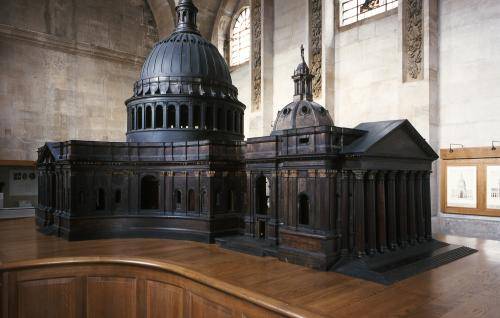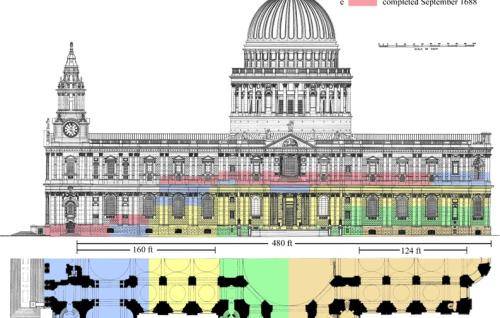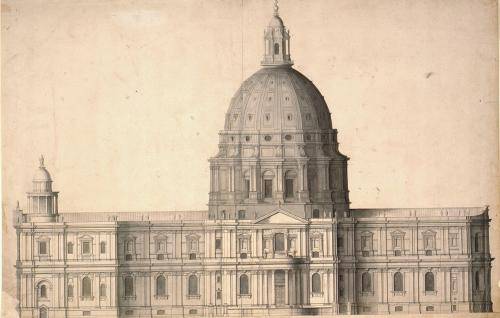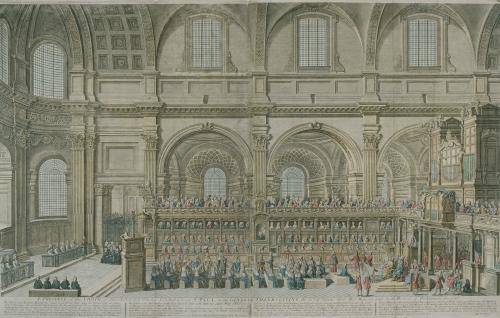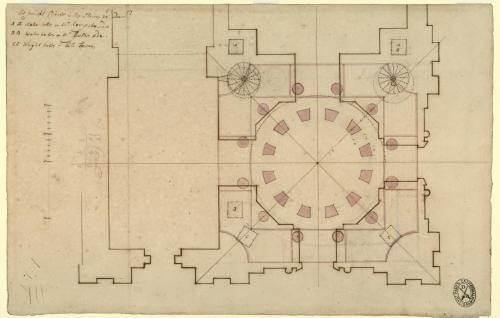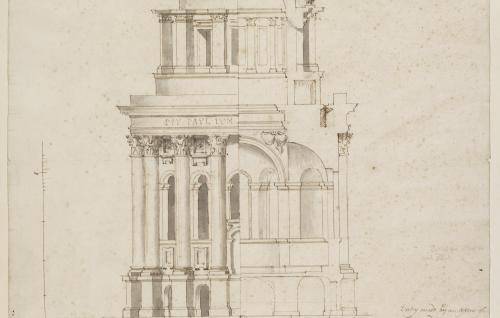5. Designs for the Dome, c. 1685-1710
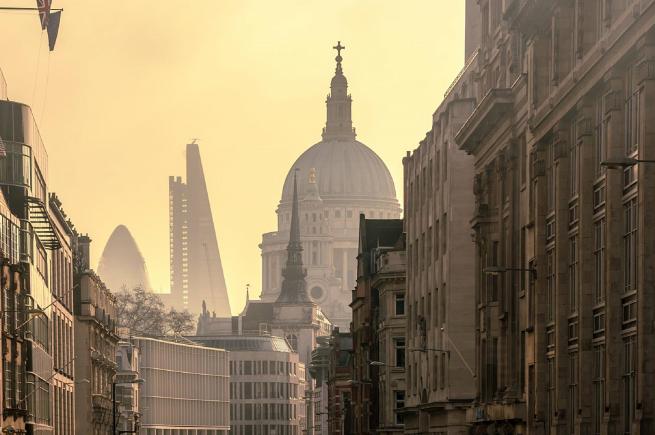
The Wren Office Drawings
c.1687–1708: Designs for the Dome
Wren’s revisions to the design in 1685–86 created a podium for a vast, richly modelled Dome, inspired by those of Michelangelo’s St Peter’s in Rome (1547–90) and Jules Hardouin-Mansart’s Invalides church in Paris (1677–91). Engravings of the Invalides church issued in 1687 revealed a timber-frame outer Dome and lantern; Wren's earliest engraved designs, produced soon after, show a Dome and lantern entirely in masonry, and a lower drum that spans nearly the full 160-ft width of the crossing square (figs 1, 2). By comparison the Dome completed in 1708 is far lighter in construction and rises from a drum only 140 ft wide externally (figs 3, 4). The outer Dome is lead-clad timber and the inner wall of the drum is sloped to carry a hidden brick cone just 1 ft 6 inches thick, its base reinforced with a wrought-iron chain. The canted inner drum and cone combine to support the tall stone lantern which appears to rest on the hemisphere of the outer Dome. They direct its weight of the lantern towards the fronts of the crossing arches and help contain the overall load of the Dome within the piers masses of the crypt.
How did Wren arrive at his remarkable final scheme? Construction began at the base of drum of the Dome in January 1696. By this time Wren would have decided on the widths and positions of the inner and outer walls of the drum and the structures that rise from them. A payment in December 1695 to Edward Strong’s masons to ‘Alter and Add to the Modell of the Legg of the Dome’ suggests final revisions to the lower part of the Dome. These revisions would have included the sloping of the inner wall, a crucial modification which allowed Wren to reduce its thickness. The masonry model altered in late 1695 was probably the ‘large Modell of 1/8 of the Great Dome’ built by Strong’s men in June 1694.
Three years earlier Strong’s men made models of a ‘quarter’ of the Dome (January to February 1691) and a ‘part of a Modell in small stones for part of the Dome’ (May 1691). To this earlier period, c.1690–91, can be assigned a group of small-scale studies which explore alternatives to the 16-bay scheme of the ‘Revised design’; see WRE/5/1. Amongst the earliest of these is a composite drawing of c.1690, mostly in Hawksmoor’s hand (fig. 5), which reduces the outer Dome in fig. 2 to a single shell and changes the design again – on the right – by setting a much larger lantern over a hemispherical Dome. This was the visual solution that Wren aspired towards but had yet to discover the structural means to achieve.
In a pen-and-ink study, now at the British Museum, Wren transformed the section of his Dome to lessen its weight (fig. 6). He was concerned to relieve pressure on the pier masses in the crypt, where, from about 1689, the internal rubble cores were beginning to settle and cause splitting in the external stone cladding. The two half-sections in the study employ a formula devised by Robert Hooke in about 1671 for calculating the curve of a parabolic Dome and reducing its thickness. Hooke had explored this curve the three-dimensional equivalent of the ‘hanging chain’, or catenary arch: the shape of a weighted chain which, when inverted, produces the ideal profile for a self-supporting arch. He thought that such a curve derived from the equation y = x3. On the right side Wren divided the half-section into four parts, each 20 ft wide. These form the ‘x-axis’ of a graph. The points of intersection with the cubes of these numbers (1, 8, 27, 64) are taken from a scale in units of 8 on the vertical ‘y-axis’ and create a parabolic curve which dictates the overall section of the Dome. Wren drew this profile more carefully in the left half-section of a 24-bay Dome. However, the parabola had to be straight-sided to support a large lantern. Working with Hawksmoor and an unknown draughtsman Wren modified the profiles in his study-design and explored variants of a triple-shell masonry Dome with straight-sided internal cones; see also WRE/5/1/6–11.
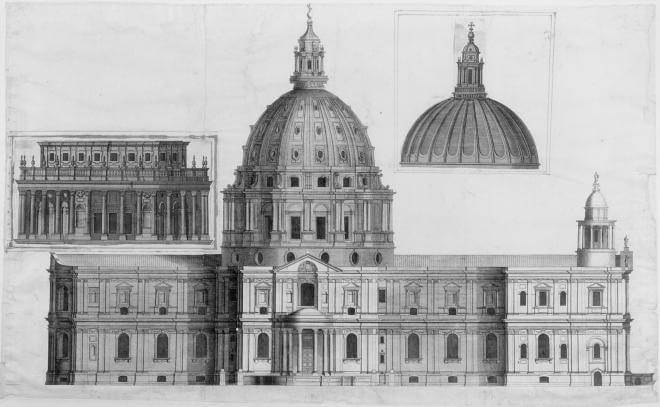
![Fig. 2. Engraving of the east–west section, probably by Simon Gribelin, c.1687–88, annotated by Hawksmoor (WRE/5/1/2[D94])](/sites/default/files/styles/image_gallery_highlight/public/2022-03/Fig%202%20Dome.jpg?itok=cMTC_bLV)
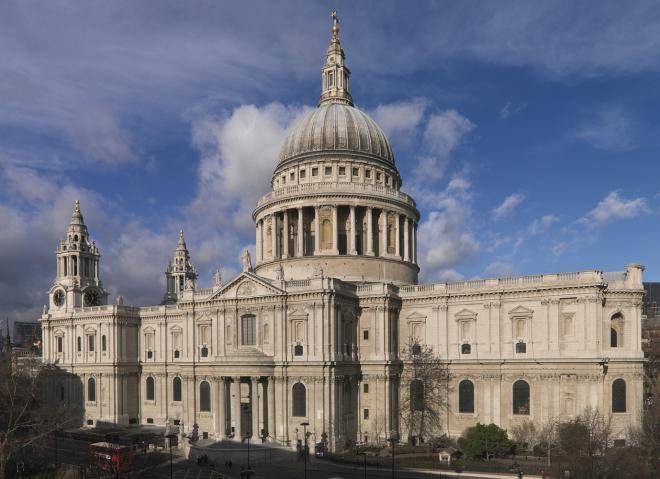
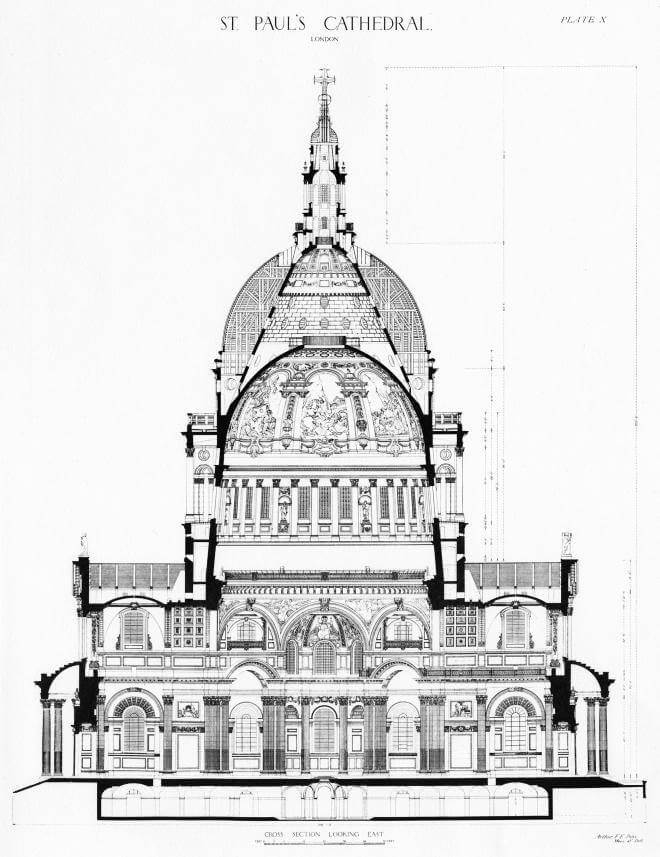
![Fig. 5. Composite section, plan and elevation of two versions of a 16-bay dome, developed from the ‘Revised design’, drawn by Hawksmoor, c.1690 (WRE/5/1/3[D95])](/sites/default/files/styles/image_gallery_highlight/public/2022-03/Fig%205%20Dome.jpg?itok=OF7jg6NK)
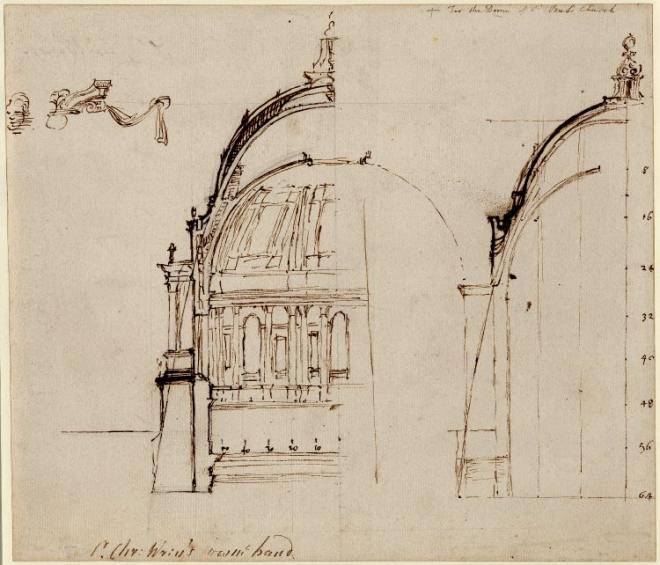
![Fig. 7. Quarter-plan of the crossing (1675), over-drawn by Wren and Hawksmoor with variant eighth-plans of the dome, the lower one c.1694 (WRE/5/2/6[D106])](/sites/default/files/styles/image_gallery_highlight/public/2022-03/Fig%207%20Dome.jpg?itok=B0lOXq9O)
![Fig. 8. Section of the dome with variant sections above the internal peristyle, the left one probably by Wren, c.1702–03, the main drawing by William Dickinson, c.1701–02 (WRE/5/3/9[D158])](/sites/default/files/styles/image_gallery_highlight/public/2022-03/Fig%208%20Dome.jpg?itok=gAZf_3s7)
In the next phase, between about 1691 and 1694, Wren introduced iron chains into the sections of his designs to contain the outward thrusts of the cone and inner Dome; see WRE/5/2. This innovation enabled Wren to reduce the depth of the peristyle and heighten his internal and outer Domes. He increased the bays in the peristyle to 32, as in the Great Model, but infilled every fourth one as a buttress. A sketch for such a Dome has two slots for the chains; see WRE/5/2/3. This study led to a series of larger scale designs, including an eighth-part plan of the Dome, shaded in colour to distinguish stone types at two levels (fig. 7). This drawing is probably preparatory for the small-scale masonry model of June 1694.
The final phase from c.1694 onwards saw Wren establishing the section of the Dome up to the top of the peristyle by the start of construction in 1696, but then modifying it soon after Queen Anne’s accession in March 1702; see WRE/5/3. In the summer of that year Anne’s first Parliament agreed a large increase in funding from coal tax to complete and decorate the cathedral, effective from 1708. This overturned a severe cut in revenue imposed under William III in 1697, when Wren’s salary was halved pending the completion of the cathedral.
A full-height section of the crossing and Dome, drawn mostly by William Dickinson, and revised shortly afterwards by Wren, reflects the cathedral’s improved financial circumstances around 1702 and the architect’s renewed ambition to crown his Dome with an imposing lantern (fig. 8). Dickinson drew three alternatives for the section above the internal peristyle in brown ink, two on the right and one on the left, the latter beneath the pink-coloured revisions. The brown-ink alternatives show that Wren had not decided on the structural form of the upper part of the Dome in 1701–02, when construction was 10 ft above the floor of the peristyle. These variants are of a Dome that supersedes a version engraved at this time. The left-hand variant is the most advanced. It eliminates the upper tier of windows in the peristyle by lowering the springing of the inner Dome. This version was then revised in freehand pink line and shading over thick pencil. Wren increased the thickness of the cone and fused its base with that of the inner Dome to provide a more solid support for a more massive lantern, which rises through the timber-framed shell of a hemispherical outer Dome.
The lantern was entrusted entirely to Edward Strong and his team of masons, one of whom may have drawn a marked-up half-section, probably for a model completed in January 1707; see WRE/5/3/10. Dickinson’s fully annotated construction drawing for the lantern’s capping, ball and cross, endorsed with instructions for gilding in November 1708, aptly concludes the sequence of drawings for the Dome; see WRE/5/3/11.
References:
Wren Society 15, p.5, 14, pp.80, 134
Downes 1988b, pp.108–23
Higgott 2004b
Geraghty 2007 pp.65–69
Campbell and Bowles 2004, pp.212–13
Higgott 2009
Gerbino and Johnston 2009, pp.102–03 and 182
Campbell 2007, pp.67–69
Lang 1956, p.220.
Links to the catalogue:
WRE/5/1 Studies for the dome in 16 and 24 bays, c.1687–1691
WRE/5/2 Studies leading to the final scheme for a 32-bay dome, c.1691–94
WRE/5/3 Designs for the final scheme, with revisions, c.1694–1708





